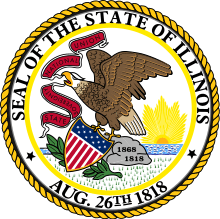Illinois Department of Veterans' Affairs
The Illinois Department of Veterans' Affairs (IDVA) is the department[2][3] of the Illinois state government that assists veterans and their families in navigating the system of federal state and local resources and benefits, provides long-term health care for eligible veterans, and helps veterans address education, mental health, housing, employment, and other challenges.[4]
 Great Seal of Illinois | |
| Department overview | |
|---|---|
| Formed | 1976 |
| Jurisdiction | Illinois |
| Headquarters | Springfield, Illinois |
| Employees | 1200 |
| Annual budget | $138,179,100[1] |
| Department executives |
|
| Website | www2 |
Duties
IDVA is an Illinois executive agency, funded and administered under the auspices of the Governor, and operates independently of US Department of Veterans' Affairs (USDVA). While the USDVA provides the bulk of healthcare and financial benefits for the nation's veterans, IDVA provides critical augmenting programs and services for Illinois veterans. Additionally, IDVA's Veteran Services Officers are experts in both federal and state benefits and resources; they assist veterans in navigating and applying for USDVA and IDVA programs and benefits. IDVA is not a part of the US Department of Veterans Affairs (USDVA, or "the VA" as it's often termed). VA medical centers (Jesse Brown, Hines, etc.) and USDVA benefits (disability compensation, etc.) are administered and funded by the federal government. The IDVA team consists of more than 1,200 staff, many of whom are veteran.
- Veteran Service Officers
- Veterans' Home Staff
- Central Office
- Special programs, including Women Veterans, the Illinois Warrior Assistance Program, Veterans Cash Grants and others.
- State-Approving Agency (SAA)
- Grants/Records
In addition, IDVA serves as a liaison to the U.S. Department of Veterans' Affairs and other federal and Illinois State agencies that provide programs for veterans. The IDVA actively partners with others who help and empower veterans, including educational institutions, county officials, and employment service personnel.[4]
History
Illinois’ long and proud history of service to veterans began in 1886 with the establishment of the Illinois Soldiers’ and Sailors’ Home for Civil War Veterans. Created through legislation enacted in 1945, the Illinois Veterans’ Commission was responsible for state services to veterans until 1976, when it was succeeded by the Illinois Department of Veterans’ Affairs (IDVA). The IDVA, created by Public Act 79-376, is charged with responsibility for the welfare and needs of Illinois veterans, their dependents and survivors. IDVA maintains administrative offices in Springfield and Chicago, four veterans’ homes, and more than 73 full- and part-time field offices servicing the 102 counties of the state.
Through the field offices, veterans and their families obtain assistance in navigating the complex system of federal, state and local resources and benefits. Acting as veterans’ authorized representatives, the Department’s accredited Veteran Service Officers provide counseling and assistance in presenting claims to the United States Department of Veterans Affairs on behalf of veterans and their dependents or survivors; these claims may include disability compensation, education benefits, pensions, insurance, hospitalization and rehabilitation. Services also include confirming veterans’ eligibility for state benefits and services, as well as assisting veterans in coordinating with local, state and federal agencies.
In FY 2014, IDVA was funded to provide skilled nursing care to more than 900 veterans each month through its Veterans’ Homes in Quincy, Manteno, LaSalle and Anna. These facilities primarily provide licensed skilled care beds available to veterans in need of long-term care; Quincy and Anna also have a limited number of domiciliary beds for residents who do not require skilled care. In addition, IDVA is assisting the design and construction process for a new 200-bed Veterans’ Home in Chicago. All of IDVA’s Veterans’ Homes are inspected by the U.S. Department of Veterans Affairs and licensed and inspected by the Illinois Department of Public Health.
IDVA assists in coordinating services and activities among state and federal agencies, as well as with non-profit organizations that serve veterans. To accomplish this, IDVA staff serve on a number of statutory committees and task forces and work in partnership with several federal agencies, including the U.S. Department of Veterans Affairs, the U.S. Small Business Administration, and the U.S. Department of Labor. IDVA has established and maintains a network of advocacy with a variety of state agencies including the Department of Employment Security, the Department of Corrections, the Department on Aging, the Department of Commerce and Economic Opportunity, the Department of Public Aid, the Department of Human Services, the Department of Military Affairs, the Department of Children and Family Services, the Department of Public Health and the Department of Healthcare and Family Services.
The key initiatives of the Department this year have been Illinois Joining Forces (IJF), a public-private network which assists service members, veterans, and their families navigate the “sea of goodwill”; increased outreach efforts through the agency newsletter and improving access to Veteran Service Officers online; programs, initiatives, and partnerships to address the veteran unemployment issue and equip Veteran-Owned Small Businesses; assistance to veterans in accessing training opportunities and transitioning their military training toward state license requirements; expansion of a Women Veterans’ Program; continued work toward opening the 200-bed Chicago Veterans’ Home; and continued support of the Illinois Warrior Assistance Program, the Veterans Cash Lottery Ticket Grant Program, Veterans Treatment Courts in various counties, and the Veterans Care Program.
See also
References
- FY2014 proposed
- Uphoff, Judy Lee (2012). "The Governor and the Executive Branch". In Lind, Nancy S.; Rankin, Erik (eds.). Governing Illinois: Your Connection to State and Local Government (PDF) (4th ed.). Center Publications, Center for State Policy and Leadership, University of Illinois at Springfield. pp. 78–79. ISBN 978-0-938943-28-0. Archived from the original (PDF) on 2013-06-22. Retrieved 2014-07-03.
- 20 ILCS 5/5-15
- http://www2.illinois.gov/veterans/about-us/Pages/default.aspx
FY2014 Annual Report http://www.illinois.gov/veterans/features/news/Documents/IDVA%202014%20Annual%20Report.pdf
FY2013 Annual Report http://www.illinois.gov/veterans/Documents/AnnualRpt2013A.pdf
FY2012 Annual Report http://www.illinois.gov/veterans/Documents/IDVA%20--%20FY%202012%20Annual%20Report.pdf